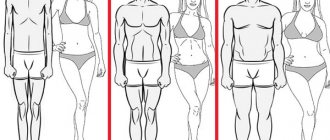We all perceive the world around us differently: some pay more attention to the appearance of people or things, some are fascinated by sounds, and some will not be able to form a complete impression of an object until they touch it.
Psychologists divide people, depending on their way of perception, into 4 categories: visuals (evaluate the world with their eyes), auditory (prefer to focus on hearing), digital (their logical mind comes first, and then everything else) and kinesthetics (connoisseurs). tactile sensations). How to understand that this is a kinesthetic person and how to find a common language with him?
Characteristic features of a typical kinesthetic person
Find out what awaits you today - Horoscope for today for all zodiac signs
Due to numerous requests from subscribers, we have prepared an accurate horoscope application for mobile phones. Forecasts will arrive for your zodiac sign every morning - it's impossible to miss! Download for free: Daily Horoscope 2020 (available on Android)
In childhood, the lion's share of people belonged to the kinesthetic type - after all, a child learns about the world through touching various objects, also trying to taste them.
Usually, in the process of growing up, the physical perception of the world slows down, and other methods come to the fore. But still, some people, even in adulthood, continue to perceive information from the outside mainly through tactile contact.
Kinesthetic – who is he and what are his main identifying “symptoms”? Let's find out.
- for the most part, a representative of this type behaves quite actively: he is often in motion, touches surrounding objects, smells them, tastes them;
- the process of perceiving the world for kinesthetics is carried out mainly through physical sensations, the body is their main tool that allows them to receive the necessary information;
- Kinesthetic learners vitally need maximum comfort and coziness around them. And now we are not talking about ideal cleanliness or order at all. Not at all - such a person can, for example, walk around in a suit that has long gone out of fashion, but which fits him perfectly, and the natural fabric gives him great pleasure when touching the body;
- A kinesthetic person always monitors the air temperature in the room they are in, because if it is too hot or, conversely, cold, they will begin to experience severe discomfort. Likewise, he can be very irritated by certain odors;
- these people unconsciously try to reduce the distance in communication - they come as close to the interlocutor as possible, accidentally touch his hand or shoulder. If this is a typical kinesthetic person, then you should not regard such gestures as manifestations of sympathy, obsession, or even less sexual interest - in this way he is just maintaining a conversation;
- touch people are not very strong in making plans for the future; they always prefer real actions to them. And when representatives of other psychotypes have not yet “swinged up” and are in the process of thinking, kinesthetics are already desperately eager to fight. And long waits and downtime can really unsettle them;
- in the same way, they hate having “meaningless” (in their opinion) conversations for hours, discussing problems if they cannot be solved in a practical way. They consider this a senseless waste of precious time;
- In order for a kinesthetic student to be comfortable, all things in his home or workplace should be located in their usual places. Although in appearance there is often an impression of complete chaos, in reality all objects are placed in a logical order that is understandable to a kinesthetic reader, so that he can always pick them up without difficulty;
- a kinesthetic person is a person who predominantly remembers the general impression of what happened, while minor details are often ignored;
- in most cases, connoisseurs of tactile sensations get along well with their body, know how to control it and correctly understand its signals;
- Mostly kinesthetic people behave reservedly in society and do not like to talk much. The fact is that they easily immerse themselves in the world of their own internal experiences and sensations, which from the outside looks like they have “gone into themselves” and stopped listening to you. If you notice such signs when communicating, there is no need to be nervous and angry with the kinesthetic learner - it’s better to lightly touch him and he will instantly “come down to earth.”
Interesting point. Do you see how a kinesthetic student is sad about something and want to please him? The best thing you can do is to embrace him in your arms. Then he will feel that he is cared for and will stop worrying.
How to treat kinesthetic learners
How to become a confident man and increase your self-esteem
When communicating with kinesthetic learners, it is better to adhere to certain rules:
- Use touch to bring you back to dialogue. Kinesthetic learners tend to drop out of the conversation, immersing themselves in their own thoughts;
- Remember delicious food. The way to the heart of kinesthetics is through the stomach;
- Give pleasant little things, for example, eau de toilette, incense sticks, candles. Despite the fact that they are not picky about clothes, they can wear things for years, and have a weakness for pleasant aromas;
- Do not take personal items or move them. Kinesthetics have an order where each object has its own place, even if from the outside it looks like chaos. It is important for them to have everything at hand;
- Create comfortable indoor conditions. At the same time, cleanliness is not in the foreground. The main thing is to create comfort so that it is fresh and warm.
Kinesthetic children require special treatment:
- There is no need to be afraid to spoil your child with hugs and kisses. There is no such thing as too much attention for them. On the contrary, a lack of affection will lead to the child withdrawing from adults and withdrawing into himself;
- Buy quality bedding and clothing. It is important for a child not only to feel warm, but also to feel comfortable. The main thing is that it feels good when it comes into contact with the skin. Therefore, preference should be given to natural materials;
- When choosing among clubs and sections, preference should be given to dancing, swimming, and martial arts;
- Typically, kinesthetic children are perceived as disorganized people. In fact, they have their own order. Among the scattered things, they will immediately find what they need. Therefore, it is necessary to agree on a position of objects that is convenient for everyone;
- Don't forget about soft toys. Such children need the presence of a “friend” whom they can hug on occasion and take with them to bed.
Child sleeps with a toy
How to identify kinesthetics by communicating with them
In addition to the fact that the bearer of this psychotype will try to touch his interlocutor, there are a few more tips:
- A kinesthetic person regularly uses words in speech that characterize various bodily or taste sensations, for example, “hot”, “cold”, “salty”, “prickly” and so on.
- Usually such people direct their gaze downward when communicating. In general, it should be noted that they rarely look directly into the eyes of their interlocutor.
A spicy nuance. During sexual games, kinesthetics prefer to turn off the lights in order to shift the focus of attention to tactile sensations as much as possible. They get great pleasure from massage, stroking, and kissing.
Relationships with a kinesthetic learner
Now let's move on to the juiciest topic. Since kinesthetics recognize this world by sensations, but in an intimate sense they feel quite good about themselves and their partner. As a rule, this psychological type is characterized by increased sexuality. While auditory learners listen, visual learners observe, and discrete ones think about them, kinesthetic learners are completely dissolved in sensations. Therefore, they prefer to have sex with the lights off so that they can indulge in the process without distractions. For this psychotype, foreplay is necessary. Foreplay is no less important than the process of intercourse itself, since every touch of a partner ignites a whole ocean of desires. The kinaesthetic body is a continuous erogenous zone and this must always be taken into account.
But even outside of bed, relationships with such people are impossible without hugs, kisses and constant touching. For them, meaningfulness fades into the background, giving way to sensuality and emotions. The well-known saying that “men love with their eyes, and women with their ears” is true only for visual and auditory people. If we are talking about kinesthetics, regardless of gender, they love with their entire skin, as well as with their taste and olfactory receptors. This is where the power of human biochemistry, especially pheromones, really comes into play.
Kinesthetic woman
First of all, let's talk about representatives of the fair sex who belong to this type of perception. They are the ones who sign up for massage sessions more often than other women, love to visit the jacuzzi, and going to the hairdresser is a real pleasure for them.
After all, there the master gently touches their hair, combs it, dyes it, blow-dries it, and all these actions are accompanied by tactile sensations. It is not surprising that kinesthetic girls usually look very well-groomed and carefully take care of their skin and hair.
They are also popular with the stronger sex due to their increased affection and tenderness: they adore kisses and hugs, and are always happy to give a pleasant massage to their chosen one.
In relationships they tend to be romantic. But in clothing, between beauty and comfort, they will definitely choose the latter. If such a girl finds it difficult to walk in high heels, then she will prefer comfortable sneakers. And she will never part with an old, but so soft and fluffy sweater for anything in the world. Even if there are a bunch of other outfits hanging in the closet.
How can a kinesthetic learner achieve his goal?
Personal effectiveness - what is it?
Kinesthetic learners need to be constantly encouraged and pushed to achieve their goals.
Important! It is difficult for them to concentrate and devote themselves to one activity at once, so outside support is important.
Making a plan with daily goals will help you cope with the task. It's better to set a time to work on a specific project so that it becomes a habit. It is everyday work that will lead to the desired result.
Male kinesthetic
Such men pay little attention to the visual appearance of a woman. When choosing a chosen one, they focus more on the shape of her body - it is important for them that touching it is pleasant. They love soft, velvety skin and a pleasant, but not too intrusive aroma of perfume.
This man pays enough attention to his appearance: he gives a comfortable haircut, and you can often catch him in a manicure chair or a massage therapist’s office.
But, just like ladies of this psychotype, they wear clothes that are as comfortable as possible, and will not chase fashion brands. He doesn’t talk much in relationships; he always describes his physical sensations in great detail.
What kind of work is suitable for kinesthetics?
With age, kinesthetics do not turn into other psychotypes. They can rely not only on sensations, but also develop visual and auditory perception, and pay more attention to thought processes. At the same time, tactile sensitivity will still be their priority. Accordingly, they need to choose a suitable profession.
If a person has a well-developed sense of smell and taste analyzers, the role of sommelier, taster, or cook is suitable for him. Perhaps kinesthetics will find itself in the perfume industry, creating new unique scents, or evaluating perfumes from different manufacturers.
Among professional massage therapists there are also many kinesthetics who have perfected their tactile sensitivity. They literally “scan” a person with their hands, finding problem areas and kneading them. Athletes, for example, wrestlers, boxers or gymnasts, go to a slightly different steppe. All active sports, as well as martial arts, attract kinesthetics, providing an outlet for their irrepressible energy.
The list of professions that may be of interest to this psychological type of people is quite extensive. It’s easier to list vacancies that definitely won’t suit them. Sedentary, routine and monotonous work will instantly drive any kinesthetic learner into prolonged depression, so it is better to avoid such employment. It is preferable for him to become a courier than an office “plankton”, even if he receives a higher salary. You can’t earn all the money, but it’s better to save your nerves.
Take the brain hemisphere test
Kinesthetic child
Kinesthetics - what is it? It is a way of perceiving the world, laid down from the first years of a person’s life. All children explore the surrounding reality through touching, squeezing objects, and also strive to taste all the toys. A true kinesthetic learner can be determined when a child attends grades 2-3.
This baby still shows a desire to touch all objects. It’s easier for him to show something than to tell him about it. In games with classmates, he often pulls girls' pigtails, hugs and kisses his friends.
Kinesthetic children show great impatience in science lessons when they are shown various models and try to study them on their own. But, it should be noted that at primary school age it can be difficult to understand whether a child really belongs to the tactile type of perception of the world or whether he is simply hyperactive and restless. Both phenomena have similar symptoms.
It’s interesting that if a kinesthetic child slouches, you will not be able to force him to straighten up by any means. At least show a thousand photos from the Internet, at least cite scientific facts that stooping is harmful to health. He won't care, because he feels comfortable in this position .
Such children enjoy using their body by conducting various experiments with it. For example, they may alternate between trying to write with their right hand and then with their left hand. Parents are often asked to send them to swimming, dancing, gymnastics or any other type of physical activity.
It will be useful for parents of kinesthetic learners to listen to the following recommendations, which will facilitate the process of assimilation of knowledge by the baby:
- for better concentration, it is worth making visual aids for lessons in the form of layouts or diagrams - so that a little kinesthetic learner can more easily absorb information;
- such a child may demonstrate a very non-standard approach to learning: for example, he simultaneously runs and solves a math problem. You shouldn’t scold him, he has his own methods;
- You definitely need to sign him up for sports, because thanks to physical activity he begins to feel much better;
- ideally, send such a child to a specialized school with an emphasis on physical development;
- You can study poetry or theoretical material with him when he does exercises - the knowledge will be absorbed.
Psychological portrait of a kinesthetic learner
To better understand who a kinesthetic person is and how best to behave with him, it is advisable to understand the characteristics of his psyche. Psychologists identify several character traits characteristic of people with this type of perception:
- Impulsiveness. Despite the characteristic calmness in communication, the kinesthetic person often begins to act without thinking through the consequences and without drawing up any plan. At the same time, he values stability, so he chooses those paths that seem to him the least risky.
- Non-conflict. Emotions for kinesthetics are comparable to physical feelings, and any conflict that may seem like a harmless showdown to other people causes them pain. Therefore, they try to avoid conflicts, and they do this very skillfully.
- Silence. Kinesthetic people speak little, which is why they seem modest and timid to others. In fact, they are simply not very talkative, and when communicating, communication is more important to them than communication.
- Melancholy. This does not mean that all kinesthetic people are melancholic. They are simply so immersed in their thoughts and feelings that they literally do not notice the events happening around them.
- Conservative. People with this type of perception do not like to rebel against established traditions. They prefer the world around them to be as predictable as possible.
It cannot be said that the listed features make a person better or worse for others. You just need to understand and take them into account, in particular, so as not to be offended that your kinesthetic friend did not notice your new hairstyle or the stylishly folded handkerchief in your pocket. But he is a very peace-loving, flexible and reliable person with whom you can build harmonious friendships or romantic relationships.
Ideal profession kinesthetic
When choosing a future job, such a person should consider those options where he can receive physical contact. After all, kinesthetics are people of action, not thinking.
A job in which they will constantly feel their body is ideal for them. Thus, tactile individuals become successful athletes, dancers, massage therapists or tasters.
Kinesthetics in life
In everyday life, kinesthetic people are quite demanding about their surrounding conditions - these people like comfort in everything.
It doesn’t matter whether it concerns clothing, furniture, the environment in general, or the ambient temperature. If you wear comfortable clothes, if you go for a walk, then if possible, in good weather. Oddly enough, such seemingly pragmatic people as kinesthetics are very prone to melancholy. Very often you can see how a kinesthetic person, completely immersed in his sensations, thinks about something.
In addition to the fact that kinesthetics in almost all situations try to achieve physical contact with an object of interest, they often rely on their intuition. It must be said that due to the peculiarities of thinking, intuition among kinesthetics is quite highly developed. If a kinesthetic person says, “I feel like it’s not worth doing this,” it’s better to listen to his opinion .
Dankina Nadezhda · 14 Feb, 2018
Auditory, visual, digital and kinesthetic
Conventionally, all types of perception of the surrounding world in psychology can be classified as follows:
- An auditory learner is a person who attaches great importance to information that he perceives by ear. He judges the surrounding reality by sounds, and the attitude of other people towards him - by their timbre of voice, intonation.
- A visual person is a person whose leading channel of perception is the visual. To remember information, he arranges it in diagrams, drawings, tables. When communicating with a person, the visual person carefully observes his facial expressions and attaches great importance to gestures and appearance.
- Digital (discrete) is an individual who, in understanding the world around him, relies on the laws of logic. He carefully analyzes any incoming information and checks it for accuracy using intelligent methods. His judgments are based on reflection.
- A kinesthetic person is a person who establishes tactile contact with the world.
Basic types of perception
Some researchers supplement the classification of basic psychotypes with such varieties as gustator (an individual who prioritizes taste sensations) and olfactor (a person who navigates the environment by smells). According to the traditional approach to classification, people who care about the taste of food and the smell of a room are called kinesthetes.
Female kinesthetics
The girl is endowed with special strong sensitivity and emotionality. Has many vulnerabilities, but is not demanding. She does not think about social status; the main thing for her is her own feelings. Experiencing convenience and comfort, she feels happy. He prefers to rely on intuition in his actions, has openness in communication, and therefore has high communication skills. It is easy for such a girl to attract the attention of a man, thanks to her kindness and affectionate nature.
The only thing is that they don’t like to talk for a long time, preferring to relax most of the time and enjoy their lives. It is important for them to have physical contact, especially when communicating with loved ones.
Important point! Women are inclined to take decisive action without wasting time on thinking, especially if their intuition gives the go-ahead for action.
Tactile contact: how to identify kinesthetics in yourself?
I didn’t have to look far for an example of a pronounced kinesthetic person: here he is, lying next to me, snoring sweetly, although he vowed to watch a movie with me to the end at least once in his life. I have never seen such a reaction to pictures as my boyfriend’s in my life. “Everything there is so bright, it flashes, and I can’t distinguish the main characters, so I’m not interested in following the plot,” Andrey answers without a grain of joke to a fair question: how can you not watch a single series in your entire life? It was not easy for the poor kinesthetic learner in the visual world: since childhood, Andrei had been memorizing the names of the main characters from cult films in order to support a serious boyish conversation in the spirit of “Batman v Superman.” But he actually didn’t see any of these pictures. Why should he agree to a new film show every time? “I’m just pleased to hug you and lie next to you,” is the selfish answer of a typical kinesthetic learner. Selfish - because this is how, through touch, a person with a dominant kinesthetic type of perception receives new information, pleasure and relaxation.
Related materials:
Sports interest: what do people talk about in gyms?…
How to determine who you are: an introvert, an extrovert or...
The right to prohibition: how to turn “you can’t” into an effective...
MAN OF ACTION
The division into types according to channels of perception can be found in two psychological concepts at once: in neurolinguistic programming and in the theory of learning styles. In NLP it is believed that all people are divided into four types: visual, auditory, kinesthetic, digital (logical). Belonging to one of them depends on which sensation is most developed in a person. Through this one, predominant channel, a person most easily perceives information, processes it and makes judgments. According to the NLP system, kinesthetics focus not on vision and hearing, but on their own sensations. Their channels of information are touch, taste, smell, reactions in muscles and the so-called meta-sensations in the body, which inform a person about the emotion that he is experiencing right now (for example, dizziness and nausea before an exam). The way a kinesthetic learner experiences the world and experiences maximum pleasure is through action.
“Just looking” will not give him anything: everything must be tried, smelled, touched, experienced first-hand, even if this experience turns into bumps and bruises. Words that a kinesthetic person often uses in speech: feel, touch, pull yourself together, touch, do. Kinesthetic learners experience pleasure when they are in direct contact with the world around them. They are the same boring people who desperately need to take a bite of cheesecake before letting it be photographed.
A similar classification is given by the widespread theory of learning styles - the VAK model (visual, auditory, kinesthetic). According to it, every person has a natural tendency towards one of the types of learning - aimed at the visual, auditory or kinesthetic system. The key word for a visual learner is look at this, for an auditory learner – listen/say this, for a kinesthetic learner – do this. Relying on “their” channel, the student perceives new information faster, is more interested in the subject, and interacts more actively with the group and the teacher.
Related materials:
Step into reality: how to stop being disappointed in...
Perfectionist Syndrome: Why Ideal People Can’t...
Corona presses: why being a narcissist really...
Important footnote: There are no people who are capable of only one learning style. Moreover, over the course of life, a person learns to equally process information from different channels. But in stressful situations, the psyche always chooses a shortcut - and the kinesthetic one will be the first to rush into battle, while the visual one observes and the auditory one discusses.
PROUD MINORITY
In the modern audiovisual world, where most areas - from shopping to education - have moved to the Internet, the kinesthetic person risks losing or even never getting to know part of his power. Since all channels of perception work for each person (albeit in different percentages), a kinesthetic person can switch to the audiovisual mode from childhood and not even suspect it. But to turn on the full potential, you will have to return to the roots. The most effective way of learning for a kinesthetic learner is through play. If in preschool age there are still at least some goodies - playing with cubes, cutting out snowflakes, modeling from plasticine, then school education completely pulls the rug out from under the feet of the kinesthetic learner.
Related materials:
No offense: how to respond to criticism?
Do I need to ask for forgiveness?
Psychologists: what is hidden behind strange handshakes...
I don’t know about you, but my school teachers saw the hyperactivity of the kids in the gallery as a reason to give them a bad mark for behavior, but not as an opportunity to develop their abilities. According to the European educational program Erasmus+, about 65% of students are visual learners, 30% are auditory learners and only 5% are kinesthetic learners. It is not surprising that the needs of the latter are often sacrificed in favor of the majority. But in addition to the dominant channel, each of us has a secondary, reinforcing one. Here tactile sensations and motor skills occupy leading positions.
In short, everything needs to be developed. But if the visual and auditory channels, thanks to popular culture, develop without any additional effort, then you need to take care of your kinesthetics separately.
GUIDE TO INCREASING QUALITY OF LIFE INTERNAL KINESTHETIC
• STUDY. How many school lessons can you remember that encouraged you not only to learn the minimum required to get a good grade, but to sift through all available sources on a topic, keep up with your parents for a week with questions, and buzz your classmates’ ears? I am only one. In sixth grade, our history teacher decided to move away from the traditional curriculum and arrange a module on Ancient Greece in the form of a multi-level game. One of the tasks was to stage a performance based on a legend that we had to choose ourselves. So, to choose a legend for the production, my friend and I read the entire Kuhn - from cover to cover. Without expecting kicks or carrots, just like that. Although they could well have chosen the first myth that came across, and the assessment would not have changed. This was not at all necessary, but we came up with costumes for our classmates (after studying materials on the topic “Fashion of Ancient Greece,” which were not even close to being in the textbook). Learned all the dates to get ahead of everyone in the quiz. And during the game itself, for the first time we felt unity and enthusiasm in our usually indifferent class. I don’t know whether it was consciously or not, but the teacher then for the first time chose a form of teaching that was most aimed at kinesthetic learners - a game. This type often has problems learning theory if it is not supported by their own experience. Although this does not mean that kinesthetic learners are loose fidgets who cannot concentrate. When they are actively involved in the process, try and reinforce the teacher’s words with specific actions, they are able to remember instantly.
Related materials:
5 ways to counteract the pessimism around you
Free your life from unnecessary things
People posting their gym photos on Facebook...
• FIND YOURSELF. A common misconception associated with the division into types of perception is that visual learners will be successful only as artists, auditory learners as musicians, and kinesthetic learners as massage therapists and cooks. Complete nonsense! This in no way predetermines success in a particular profession. The point is different - depending on the type of perception, the method with which it is easiest for a person to enter the work flow and get maximum pleasure from the work differs. For example, it is important for a kinesthetic artist not only to see the picture, but also to be up to his ears in paint. Therefore, he would rather prefer to work with huge canvases than traditional painting, where it is convenient to paint not just with brushes, but with rollers, brooms, or even with his own body. For the same reason, kinesthetic learners love to work with engraving, a type of graphics that requires a whole bunch of tools. For example, for etching you need a metal plate, pens with which to scratch the design, special varnishes and acids. “It turns out that I see my future work first with my hands, and only then with my eyes,” explains Ira, a graphic and kinesthetic artist who has been creating and selling prints using the etching technique for six years. In the same way, for a kinesthetic musician it is not enough just to hear - it is important to feel what the instrument is made of, how it comes to life under the fingers. The key to success for kinesthetic learners in any activity is to start with movement and tactile sensations, and not with a sketch or discussion of a plan for a future project. In critical situations, always choose action and only then smoothly switch to planning and control modes. Your winning tactic is to cut out the unnecessary and adapt to new conditions along the way, rather than try to calculate everything at once and write it down completely. As artists say after the first stroke: the canvas is ruined, now you can start painting. • CHOOSE A STYLE. The traditional uniform of a kinesthetic student, who is not too concerned with visual special effects, is loose-fitting items made from natural fabrics, often in dusty shades. By the way, recycled fashion images fit perfectly into the style of such a person. No matter how much you explain to a kinesthetic girl that neoprene does not cause any unpleasant sensations to the skin, she is unlikely to be tempted. Tactile hedonists will never fall for the external attributes and photogenicity of an outfit if it even slightly rubs, irritates the skin or cuts into it. So as long as there is at least a small percentage of pure kinesthetics left in the world, you don’t have to worry that all retail will go online. “Being able to touch something before you buy it, while it’s not yours, is an important part of the shopping experience,” says my friend Anya, a fashion designer. While working on creating her brand, Anya planned to sew clear basic models whose fit was easy to predict, and wanted to develop sales exclusively via the Internet. But over time, the concept had to be adjusted: Anya realized how important it is for customers to first touch and feel the item on their body. “While I can’t afford a full-fledged showroom, I invite potential customers to try them on right at home. When a girl comes, I treat her to Turkish coffee with cardamom, dark chocolate, and only then does she try on dresses. The result is the ideal customer service for a kinesthetic learner - a combination of pleasant tastes, smells and tactile sensations.” • TAKE CARE OF YOURSELF There is more to the way Anya presents clothes than just effective sales. She creates a kind of ritual, focused on awakening the senses and devoting time to yourself. The kinesthetic formula “How you feel is more important than how you look” is gaining popularity in the beauty industry. Alicia Yoon, founder of the online Korean cosmetics store Peach & Lily, in an interview for The Business of Fashion, notes that women are increasingly inclined to a leisurely pace of life and the development of sensations. In this regard, products that primarily provide sensual pleasure are gaining popularity: scented candles, refreshing sheet masks, fragrant oils for bathing and showering. Consumer trends analyst Karen Grant adds that in the coming years, demand for personal care products will skyrocket, while demand for beauty products will decline.
Related materials:
Shadow of choice: How to stop choosing and start living?
Why the hunt for Pokemon has driven the world crazy
7 Habits of Extraordinary People
• Tune in to bodily pleasures
Touch Without naming brands or names, have you ever noticed that sometimes you want to buy ice cream simply because instead of rustling plastic, it is wrapped in craft paper that is pleasant to the touch, which evokes associations with an eco-friendly, natural lifestyle? Experiments with craft paper, which brings kinesthetics into unconditional delight, have pulled more than one type of offline business out of the abyss. Manufacturers of notebooks, books and magazines realized in time that it was not visual special effects that would help them retain their audience, but a pleasant-to-touch shell. Even the illustration design that is popular today reproduces the effect of a hand-drawn drawing—uneven, disproportionate, and far removed from clip art examples. Take a bite Another epicurean joy for a kinesthetic learner is to eat a lot and deliciously, preferably directly with your hands. Take it for granted: you are unlikely to be able to follow even the simplest diet, because tastes are an important part of information from the outside world, without which kinesthetics cannot do without. What saves us is the fact that physical activity brings kinesthetics no less pleasure. And by the way, if you have a sedentary job, get up from your desk at least every half hour - this is not only good for your health, but will also allow you to better concentrate on the tasks at hand. Touch In sex, a kinesthetic person is never faced with the question of whether to leave the light on or not. From the very first seconds, he focuses so much on the sensations that the other channels literally turn off, so he won’t even remember whether there was any lighting. And although kinesthetics easily master the art of pleasure at the level of intuition, to expand their experience they need to learn to mute the dominant channel and turn on the other two fully. Thus, for kinesthetics in search of new sensations, it is important not so much to delve into the intricacies of tantra or intimate massage, but rather to learn to speak out your desires out loud and stimulate your imagination with visual images.
Tags: kinesthetics, psychology
Male kinesthetics
Men who are kinesthetically inclined prefer to greet a person with a handshake or a hug, as they want to feel the touch. During communication, they prefer to conduct a dialogue with one interlocutor, without wanting attention from a large number of people.
Psychology of male kinesthetics:
- They face difficulties in expressing feelings and emotions. If they want to appear indifferent, they are like an open book, showing their state of mind.
- They tend to be impulsive, hot-tempered, and at the same time quickly cool down.
- They are demanding to show respect for their own feelings at a given moment in time.
- They prefer to remain silent, and express feelings in the form of actions and touches.
Children's kinesthetics
Kinesthetics, what is it in a child? Every child is a kinesthetic learner. They begin their understanding of the world through touch. They take everything they can into their hands, try to bite, the mother recognizes it thanks to the smell. Over time, they take advantage of new opportunities in interaction with reality. During this period, kinesthetics takes on secondary importance for some.
Child Features:
- Incoming data is best remembered through movements, based not on the details of perception, but on the emotions received.
- He prefers to devote his free time to physical movements, jumping, running and the like...
- Has trouble concentrating.
- When starting a conversation, he prefers to look down.
- The perception of new data is more adaptive during physical interaction.
What are the classifications based on the way of perception?
In this regard, psychology divides people into types: auditory, visual, digital and kinesthetic . Some people need visual images (visuals) to perceive, some people need sounds (auditory), some people need touch (kinesthetics), and for some, the mind prevails over all senses (digitals).
For each type, it is important to receive information in a certain order and through appropriate sensations.
This article will focus specifically on those who perceive the world around them through touch, namely kinesthetics.
What to do if the client turns out to be a kinesthetic person
When a representative of a particular field has to deal with a kinesthetic client, he needs to use the following algorithm:
- When establishing contact with a tactilely oriented client, a person needs to maintain an open posture and demonstrate location. A sales consultant, for example, can stand next to a potential buyer, and an office employee, demonstrating interest in solving the client’s problem, should lean forward slightly.
- In the process of clarifying the client’s request, the specialist must use non-verbal body signals. If the client suddenly becomes silent, you need to bring him back to reality with the help of an unobtrusive touch.
- To motivate a potential buyer, the seller must provide him with the opportunity to touch the product and check the strength of the material using sensors.
Kinesthetic learners in the profession: where can they best prove themselves?
Considering the fact that tactile sensations predominate in kinesthetic people throughout their lives, psychologists advise them to choose a profession related to these industries. For example, if a kinesthetic person has developed taste qualities, he can become a good cook, taster, or sommelier. Kinesthetics are often found among perfumers.
Many become cosmetologists and massage therapists because they have a good feel for the skin and muscles and identify problem areas. Women with this type of character become masters of needlework. They knit, sew, embroider, sculpt and weave high-quality crafts.
Among kinesthetics there are many aesthetes, connoisseurs of beauty. They understand the value of manual labor and attach great importance to it.










